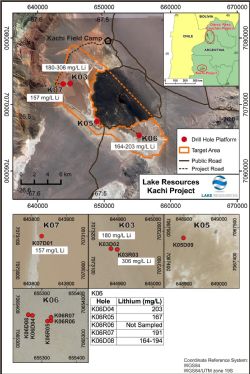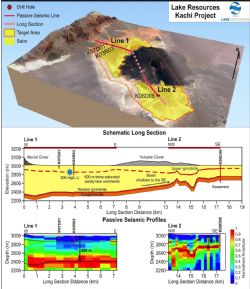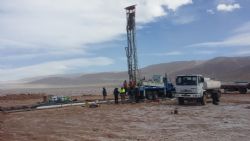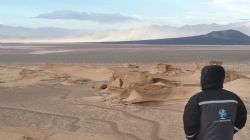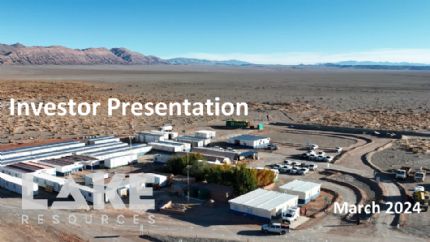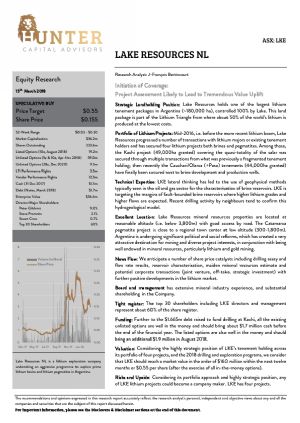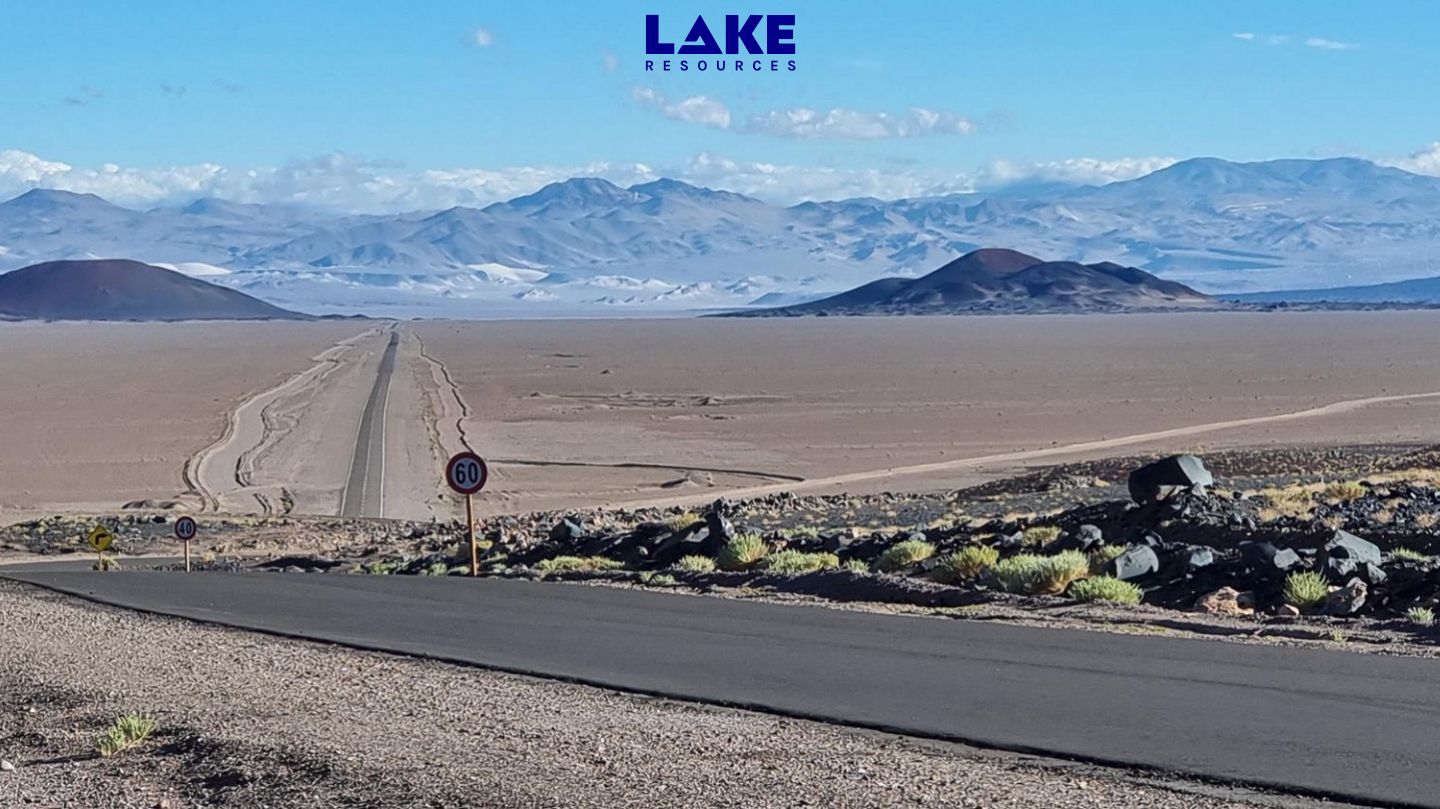
Kachi Drilling Reinforces Confidence in Scale of Discovery
Brisbane, June 14, 2018 AEST (ABN Newswire) - Argentine-focused lithium exploration and project development company Lake Resources NL ( ASX:LKE) is pleased to provide an update on drill results and ongoing exploration activities at its 100%-owned Kachi Lithium Brine Project in Catamarca Province.
ASX:LKE) is pleased to provide an update on drill results and ongoing exploration activities at its 100%-owned Kachi Lithium Brine Project in Catamarca Province.
- Initial drilling confirms the Kachi Lithium Brine Project is an exciting maiden discovery of a very large and deep salt lake basin, of similar size to globally significant lithium producers.
- Kachi is likely to be a partially covered salt lake over 22 x 8 kilometres that hosts a very large lithium brine body with potential to increase further.
- Eight rotary and diamond drill holes ended in lithium brine-bearing sediments. Results reported for 7 resource drill-holes, from 3 drill platforms, with variable depths up to 405 metres.
- Highlight is drill-hole K03R03 (northern area), with higher brine grades closer to the centre of the basin averaging 306mg/L lithium, low impurities and low average Mg/Li ratio of 4.3, a ratio similar to large Argentine projects of Galaxy and Neo Lithium.
- K03R03 results indicate higher concentrations of lithium bearing brines occur at depth in the northern area compared to shallow drilling (<150m) from platform K03. Drilling is underway to explore deeper sections below the best results from K03.
- Passive Seismic Geophysical survey indicates lake sediments continue to depths greater than 600m. Drilling results from site K06 correlate with seismic survey results.
- Excellent passive seismic data vindicates the exploration approach and aids planning of additional drilling sites. The results of K03R03 in the north are being followed up to establish the lateral and depth extent of higher lithium grades and to assess flow rates.
- Drilling continues to expand the data set for an initial resource estimate in the coming months.
- Work in Jujuy province continues, aimed at gaining drill access to the Cauchari area.
The Company can now definitively demonstrate that lithium brine is present from near surface to over 400m depth in drill holes spaced 11km apart (see Figure 1 in link below) across the project. Drilling and seismic geophysical surveying also confirms Kachi is a very large-scale partially covered salt lake over an area of at least 22 x 8 kilometres (more than 150 km2). Brine is interpreted to continue in sandy sediments beneath gravels and volcanic rocks with the potential to increase this area significantly as they may hide the true size of the basin.
Lake has been conducting two concurrent phases of drilling operations:
1. Resource and exploration drilling utilising a diamond drill rig to collect drill cores for porosity assessment and to obtain brine samples for resource estimation, and
2. Production well drilling using rotary drill rigs for additional resource estimation data and construction of wells for test pumping purposes. These will be available to pump lithium brine into trial evaporation ponds and test the brine evaporation and chemical evolution under site environmental conditions. A total of eight drill holes have been completed on three separate drill platform locations (see Figure 1 in link below).
Note: A change in naming convention for drill sites and drill hole identification has been undertaken for management purposes where D represents diamond drill holes and R rotary drill holes.
Resource Drilling - Kachi Lithium Brine Project
Lake Resources' 100%-owned Kachi Lithium Brine Project in Catamarca province, Argentina covers over 50,000 hectares of mining leases owned 100% by Lake's Argentine subsidiary, Morena del Valle Minerals SA. These are held over the centre of the known Kachi salt lake in the deepest part of the basin. Surface sampling has revealed positive lithium results in brines, which are being explored at depth through the drilling and geophysics programs.
The current status of resource diamond drilling comprises the completion of four diamond drill-holes on four platforms and analysis of brine samples. A further diamond drill hole is currently underway at a new location (platform K05). Four rotary wells have also been drilled to date with a further drill hole recently started on platform K03 in the west of the project. Table 1 (see link below) provides drill hole location details and lithium results which are averaged where multiple samples have been taken at a single interval.
Recent drilling intersected different interlayered lithologies which are dominated by sandy sediments. Samples have been collected for porosity tests in a laboratory in the USA with extensive experience in analysing salt lake sediments for their porosity characteristics, in particular the specific yield (also known as drainable porosity). Given the success of exploration in confirming elevated lithium concentrations and favourable sandy sediments for brine extraction the company intends to conduct a resource estimate for the project in accordance with the JORC reporting code as soon as practical. This will include the porosity data and systematic brine analyses from the drilling samples.
Analytical results for lithium to date have been highest in drill-hole K03R03 (northern area). Brine samples in this hole display encouraging densities with a favourable Mg/Li ratio of 4.3. This area is a key target for ongoing investigation. In the short term drilling will return to this area and target deeper unconsolidated brine bearing sediments confirmed by the passive seismic geophysical survey. Figure 2 (see link below) shows an extensive area with potentially very deep lake sediments in the vicinity of K03 that is yet to be investigated.
Diamond drilling intersected thick intervals of intercalated sands, gravels and sandy clays with some clay horizons. The predominant litho-type of lake sediments is sand-dominant, and poorly consolidated, with relatively low core recoveries in sandy material. Initial indications from field hydraulic testing indicate high permeabilities for the sandy material, which will be further tested with the installation of large diameter production test bores.
The deepest drilling to date at 405m has been undertaken in the south of the project area in diamond drill hole K06D08 (see Figure 1 in link below).
Brine Chemistry
Brines with high density (1.18 - 1.22 g/cm3) have been intersected in thick sandy and gravelly aquifers, with the best results to date being 306 mg/L after 27 hours of airlifting from hole K03R03, installed with filters over an interval of 3 - 242m. This is located further towards the centre of the northern area of the salt lake. To date the lithium brines analysed show positive chemistry with low combined impurities (boron, sulphate, calcium, magnesium, iron). A number of sample results are pending from recent drilling from site K05 and regular updates will be provided as drilling progresses.
Average lithium grades from deeper levels (350 - 400m) in the south at K06 also show high density (1.2 g/cm3), however the brine grade of 180 mg/L suggests that the brine is distinct from that at the K03 site. Deeper horizons are now being targeted in the vicinity of site K03 where positive results have been previously found with the aim of locating higher grades and extend the potential size of the brine mineralisation.
Geophysical Survey
A seismic geophysical survey is being undertaken using passive seismic techniques, with the aim of developing an understanding of basin geometry and thickness of the sediments hosting the brine. This method distinguishes lithologies with highly contrasting seismic velocities such as unconsolidated lake sediments and harder cemented sediments, basement rocks or ignimbrites (compact volcanic ash units) and has been used very successfully on a number of salt lake projects in South America and Australia. To date 170 stations have been processed.
The distinct reflectors identified in the survey correlate well with dense lithologies such as a number of ignimbrite units within the predominantly sandy sediments and probable basement rocks intersected at 300m depth in K06D08 in the south of the project area (see Figure 2 in link below). Drilling at K06 provides a correlation with the seismic survey and indicates the presence of unconsolidated sediments to a depth in excess of 500m under gravel cover away from the areas of surface salt where drilling is currently being conducted and in excess of 600m in the vicinity of site K03. Figure 2 (see link below) shows a schematic cross-section and raw data used for the interpretation.
Importantly the seismic survey also suggests the majority of the basaltic volcanic material visible at surface forms a thin veneer overlying lake sediments, which is very positive for the project as it further increases the volume of sediments that potentially host brines.
To view tables and figures, please visit:
http://abnnewswire.net/lnk/ONDL4OF1
About Lake Resources NL
 Lake Resources NL (ASX:LKE) (OTCMKTS:LLKKF) is a clean lithium developer utilising state-of-the-art ion exchange extraction technology for production of sustainable, high purity lithium from its flagship Kachi Project in Catamarca Province within the Lithium Triangle in Argentina among three other projects covering 220,000 ha.
Lake Resources NL (ASX:LKE) (OTCMKTS:LLKKF) is a clean lithium developer utilising state-of-the-art ion exchange extraction technology for production of sustainable, high purity lithium from its flagship Kachi Project in Catamarca Province within the Lithium Triangle in Argentina among three other projects covering 220,000 ha.
This ion exchange extraction technology delivers a solution for two rising demands - high purity battery materials to avoid performance issues, and more sustainable, responsibly sourced materials with low carbon footprint and significant ESG benefits.
| ||
|



